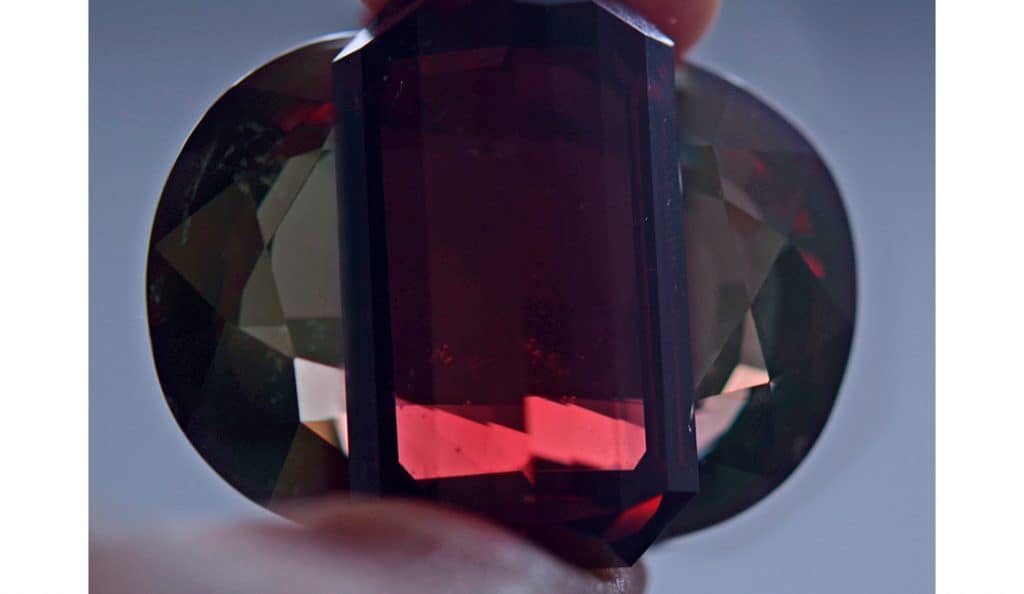
Exceptional Colour Change Garnets Showing the Usambara Effect

by Dr. M.S. Krzemnicki, first published in Facette 21 (February 2014)
Colour change, also known as“alexandrite effect” has been studied extensively since it was first described in 1831 for alexandrite (chromium-bearing variety of chrysoberyl) from Russia (von Pott, 1842). Since then, numerous minerals or gemstones with colour change have been documented (Figure 1), including corundum, spinel, zircon, fluorite, monazite, bastnäsite, garnet, diaspore, kyanite, epidote and kornerupine, to name a few.
Traditionally, we speak of a colour change when the main hue of a mineral in daylight differs from that seen in incandescent light (LMHC 2010, Infosheet No. 9). With the advent of new light sources (fluorescent and LED lamps), and recently with the ban of incandescent tungsten bulbs, this definition may need further specification in future. The main factors for observation of colour change in a gemstone/mineral are: a) two white light sources of distinctly different emission spectra (e.g. daylight versus incandescent light), b) a material that shows two transmission “windows” in its absorption spectrum separated by an absorption band at approximately 570 nm, c) an observer whose brain interprets the incoming residual light energies into an according colour sensation (White et al., 1967; Nassau, 1983; De Valois & Jacobs, 1984). Apart from colour change, there are further colour effects, which may considerably contribute to the colour perception of a mineral or gemstone, namely pleochroism (Liu et al. 1995) and the Usambara- effect (Halvorsen, 2006). Pleochroism describes the effect of different colours due to different selective absorption along the two or three vibrational directions within an anisotropic mineral (very distinct in alexandrite), whereas the Usambara effect is a colour change effect related to the path length of light transmitted in a stone (Halvorsen & Jensen 1997).
In 2013, we received for testing a few exceptionally large colour change garnets (50-100 ct) that showed a distinct and attractive colour change from brownish green in daylight to red in incandescent light (Figure 2). Based on the information of the suppliers of the stones, these came from southern Tanzania. Chemical and spectroscopic analyses confirmed that these garnets belong to the pyrope-spessartine solid solution series with marked concentrations of chromium and vanadium, well-known in literature to produce a colour change in garnet. We had analysed many similar garnets from East-Africa (Krzemnicki et al. 2001) in the past, but mostly in the range between 1 – 5 ct and only very rarely larger than 10 ct.

Apart from their very outstanding size, these new samples showed another very attractive colour change effect, the so-called Usambara effect. This specific effect, first noted by Manson & Stockton (1984) as “colour-shift” on colour-changing garnets was only later fully described by Halvorsen & Jensen (1997) on Cr-bearing tourmaline from the Usumbara mountain range, and thus named the Usambara effect. It describes the property of a material to change colour in relation to the path length that light travels through the material. In the case of our garnets of equally greenish colour in daylight, we can observe a dramatic change of their transmission colour into red when held together and illuminated with a strong light source from behind (Figure 3). This specific “colour change” is not related to different white light sources (as is the alexandrite effect, i.e. classical colour change), but is directly linked to the different path lengths that light travels through the material when viewed alone or when put together (resulting in a “doubling” of the path length).

Gem Dreams ltd., Bangkok.

Although garnets showing a classical colour change superposed by an Usambara effect have already been described (Manson & Stockton 1984), it is to our knowledge the first time, that this effect is so easy to see – even without superposition of a second stone. Due to their exceptionally large size, these colour-change garnets display a brownish-green colour in daylight in the main part below the table (+/- simple light transmission through the volume of the stone), but reddish facet reflections around the girdle as a result of increased (“doubled”) path lengths of light by internal reflections (Figure 2). This effect is not visible when illuminated by an incandescent light source, resulting in an overall reddish colour of the garnets due to their colour change (alexandrite effect).


